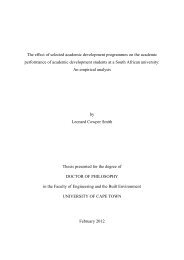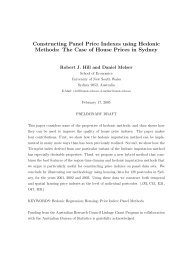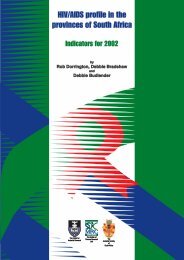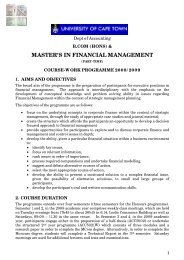Competition and Regulation in the Telecommunications Industry in ...
Competition and Regulation in the Telecommunications Industry in ...
Competition and Regulation in the Telecommunications Industry in ...
You also want an ePaper? Increase the reach of your titles
YUMPU automatically turns print PDFs into web optimized ePapers that Google loves.
<strong>Competition</strong> <strong>and</strong> <strong>Regulation</strong> <strong>in</strong> <strong>Telecommunications</strong>callback services have sprung up <strong>in</strong> countries like <strong>the</strong> USA whereby a customer fromSouth Africa places a call ‘as if’ <strong>the</strong>y were <strong>in</strong> <strong>the</strong> USA through <strong>the</strong> callback operatorcall<strong>in</strong>g <strong>the</strong>m <strong>and</strong> connect<strong>in</strong>g <strong>the</strong>m to <strong>the</strong> number <strong>the</strong>y wanted to call. F<strong>in</strong>ally, <strong>in</strong>mobile telephony one can arrange <strong>in</strong>ternational roam<strong>in</strong>g agreements for mobilephone users to capture <strong>the</strong>ir consumption. Any calls that <strong>the</strong>y make abroad will berouted back through <strong>the</strong> domestic network, allow<strong>in</strong>g <strong>the</strong> domestic mobile networkprovider to capture some of <strong>the</strong> charges on that call.However, for basic voice products <strong>in</strong> <strong>the</strong> local access market, <strong>the</strong> competition mustcome from domestically situated firms. As such, provisions around foreign ownershiplimits will serve to restrict competition.1.3 Role <strong>in</strong> <strong>the</strong> economyCommunications services play a key role <strong>in</strong> any economy – from be<strong>in</strong>g an important<strong>in</strong>termediate <strong>in</strong>put to bus<strong>in</strong>ess, an enabl<strong>in</strong>g medium for a range of content providers,a significant item <strong>in</strong> household expenditure, <strong>and</strong> f<strong>in</strong>ally a source of dem<strong>and</strong> fornumerous manufactur<strong>in</strong>g <strong>and</strong> service <strong>in</strong>dustries. What follows is a discussion of <strong>the</strong>role <strong>in</strong> <strong>the</strong> broader economy of communications services as a package of bothnetwork <strong>and</strong> service providers. This component is severely limited by <strong>the</strong> statisticaldata. This is particularly problematic <strong>in</strong> a dynamic <strong>in</strong>dustry as dated statistics tend tobe widely off <strong>the</strong> mark. With telecommunications statistics, it is likely that datedstatistics will underestimate <strong>the</strong> role of <strong>the</strong> sector <strong>in</strong> <strong>the</strong> economy.1.3.1 Role as Intermediate InputThe role of communications as an <strong>in</strong>termediate to bus<strong>in</strong>ess can be seen to have 2dimensions – a) as a cost item required to operate a bus<strong>in</strong>ess, b) as a strategic <strong>and</strong>competitive tool.As a cost item, communications does not appear that significant for most parts of <strong>the</strong>South African economy judg<strong>in</strong>g from <strong>the</strong> statistics <strong>in</strong> table 1.3 below. It representsonly 0.1% of total costs <strong>in</strong> agriculture <strong>and</strong> m<strong>in</strong><strong>in</strong>g, 0.4% <strong>in</strong> manufactur<strong>in</strong>g <strong>in</strong>dustries<strong>and</strong> 4.4% <strong>in</strong> service <strong>in</strong>dustries. However, <strong>the</strong>se figures def<strong>in</strong>itely underestimate <strong>the</strong>cost importance of communications for two important reasons. First, <strong>the</strong> data networkcosts are accounted for under <strong>the</strong> section titled bus<strong>in</strong>ess services, along with o<strong>the</strong>rbus<strong>in</strong>ess service items. Second, <strong>the</strong> latest <strong>in</strong>put-output data available for SouthAfrica is 1997, which was based on <strong>the</strong> 1993 table which was based on <strong>the</strong> 1988table. In each case, a new <strong>in</strong>put-output table is created by adjust<strong>in</strong>g <strong>the</strong> old one withnew national accounts data.As a strategic competitive tool, communications are becom<strong>in</strong>g more <strong>and</strong> more vital tobus<strong>in</strong>esses globally. Increased globalisation has resulted <strong>in</strong> <strong>the</strong> requirement tocommunicate <strong>and</strong> transmit vast amounts of data to suppliers, <strong>in</strong>dustry customers <strong>and</strong>affiliates <strong>in</strong>ternationally on a timely basis. The rise of electronic commerce, has nowestablished a need <strong>in</strong> many <strong>in</strong>dustries to use communications networks to deal with<strong>the</strong> f<strong>in</strong>al dem<strong>and</strong> of <strong>the</strong> household consumer too. In both cases, <strong>the</strong> need is for highspeed, high quality communications services that are geared to <strong>the</strong> specific needs of<strong>the</strong> firm <strong>and</strong> which are available at a cost that does not make it prohibitive tocommunicate or put <strong>the</strong>m at a competitive disadvantage to firms <strong>in</strong> o<strong>the</strong>r countries.What matters most for an economy is <strong>the</strong> availability of world-class communicationservices at a reasonably competitive price, even if <strong>the</strong>y are not <strong>the</strong> cheapest.12
















